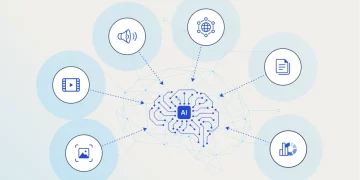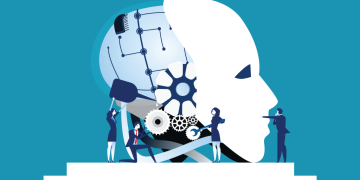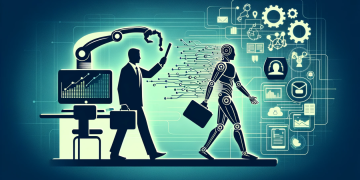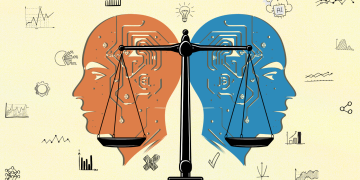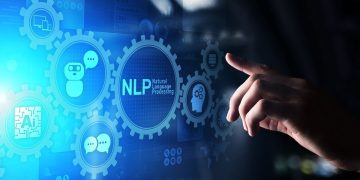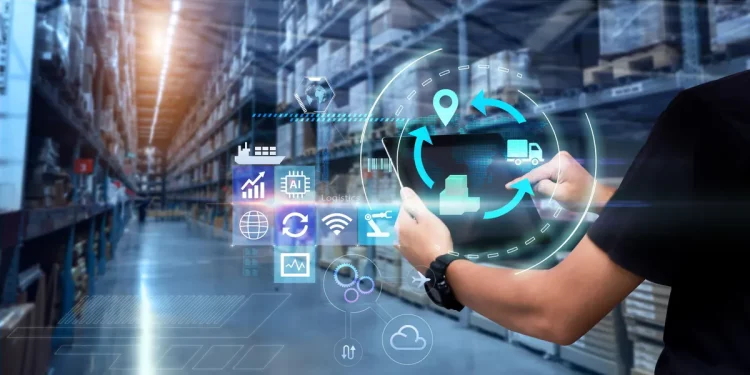The integration of Artificial Intelligence (AI) into supply chain management (SCM) has reshaped the way businesses operate globally, particularly in the retail sector. Retailers, facing ever-increasing demands for efficiency, cost reduction, and quick delivery times, have adopted AI to improve logistics, enhance forecasting, optimize inventory management, and provide seamless customer experiences. In this article, we will explore the profound impact of AI on supply chain management, highlighting key applications in logistics, efficiency, and how global retailers have leveraged AI to revolutionize their operations.
1. The Role of AI in Modernizing Supply Chain Logistics
Supply chain logistics is the backbone of any retailer’s operations, as it involves managing the movement of goods from suppliers to customers. Traditional methods of managing logistics involved manual planning, human decision-making, and limited visibility across the supply chain. However, with the advent of AI technologies, retailers can now achieve real-time visibility, predictive insights, and optimized routing, significantly improving efficiency and reducing costs.
AI-Driven Route Optimization
One of the key applications of AI in logistics is route optimization. With global supply chains, managing deliveries across multiple regions and countries can be a complex and costly process. AI algorithms can process vast amounts of data to determine the most efficient routes for delivery trucks, considering factors such as traffic conditions, weather, road closures, and fuel consumption. Retailers like Amazon and Walmart are leveraging AI for route optimization, significantly reducing delivery times and fuel costs.
For example, Amazon uses AI in its Delivery Service Partner Program to optimize routes for its delivery drivers. By predicting traffic patterns and analyzing historical delivery data, AI helps Amazon make real-time adjustments to delivery routes, ensuring that packages are delivered in the most efficient and timely manner possible. This improves both the customer experience and operational efficiency.
Predictive Analytics in Supply Chain Logistics
AI-powered predictive analytics have proven to be invaluable in supply chain logistics, allowing retailers to forecast demand and optimize inventory management in real-time. By analyzing historical sales data, market trends, and external factors, AI can predict demand for specific products, enabling retailers to better align their logistics strategies with customer needs.
Home Depot, for example, uses AI to forecast demand for products in its stores and warehouses. By analyzing customer purchasing patterns and external factors such as weather or local events, AI can predict when certain products will experience a surge in demand. This enables Home Depot to adjust its inventory levels and logistics strategies, ensuring that products are available when customers need them while minimizing excess stock.
Predictive analytics not only helps with demand forecasting but also assists in proactive problem-solving within the supply chain. For instance, AI can identify potential disruptions, such as delays at a port or factory, and suggest alternative logistics strategies to minimize the impact of these disruptions. This level of foresight helps global retailers maintain a smooth and uninterrupted supply chain.
2. AI in Inventory Management: Achieving Optimal Stock Levels
Inventory management is one of the most critical areas where AI has made a substantial impact. Retailers must strike a delicate balance between having enough stock to meet demand and avoiding overstocking, which ties up capital and leads to wasted resources. AI enables retailers to automate inventory management, predict demand more accurately, and optimize stock levels in real-time.
Real-Time Inventory Tracking
Traditional inventory management systems often struggle to keep up with the demands of a global retail supply chain. However, AI-powered systems provide real-time visibility into inventory levels across multiple locations, including warehouses, distribution centers, and retail stores. By using AI sensors, RFID tags, and machine learning algorithms, retailers can track inventory in real-time, reducing the risk of stockouts or overstocking.
Zara, the Spanish fashion retailer, has implemented AI-driven inventory management systems to streamline its operations. Zara uses real-time inventory tracking to monitor the sales of its clothing items and adjust production schedules accordingly. This enables the company to respond quickly to changing fashion trends and minimize excess inventory, which can lead to markdowns and loss of profit.
Automated Replenishment Systems
AI-driven automated replenishment systems are another major breakthrough in inventory management. These systems can predict when stock will run low and automatically trigger orders to replenish inventory before stockouts occur. Retailers like Target and Walmart use AI to optimize their replenishment processes by continuously monitoring sales data and adjusting inventory levels across their supply chain.
For example, Walmart uses AI to manage the replenishment of grocery items in its stores. The company’s AI system can predict the demand for specific grocery items based on sales patterns and weather forecasts, ensuring that stores are stocked with the right products at the right time. This helps Walmart maintain a lean inventory while meeting customer demand in a timely manner.
3. AI and Machine Learning in Demand Forecasting
Demand forecasting is one of the most challenging aspects of supply chain management. Retailers need to predict future demand for products in order to optimize inventory levels, reduce waste, and improve customer satisfaction. AI and machine learning algorithms have revolutionized demand forecasting by enabling more accurate predictions based on vast amounts of data.
Improved Accuracy Through Machine Learning
Traditional demand forecasting relied on historical sales data and simple models to predict future demand. However, AI and machine learning algorithms can analyze far more complex datasets, including external factors such as weather patterns, economic conditions, and consumer sentiment. By continuously learning from new data, AI algorithms can improve forecasting accuracy over time.
For instance, Unilever uses AI to forecast demand for its wide range of consumer products. The company’s AI system analyzes data from multiple sources, including sales data, market trends, and external factors, to generate highly accurate demand forecasts. This enables Unilever to optimize its supply chain, reduce excess inventory, and ensure that products are available when customers need them.
AI in Seasonal and Event-Based Forecasting
AI is particularly effective in forecasting demand for seasonal products or products tied to specific events, such as holidays or promotional campaigns. Retailers can use AI to predict surges in demand and adjust their supply chain strategies accordingly.
Coca-Cola uses AI to forecast demand for its beverages during peak seasons like the summer months or around major sporting events. By analyzing historical sales data and external factors, AI can predict when and where demand for Coca-Cola products will spike, allowing the company to adjust its production and distribution strategies to meet that demand.
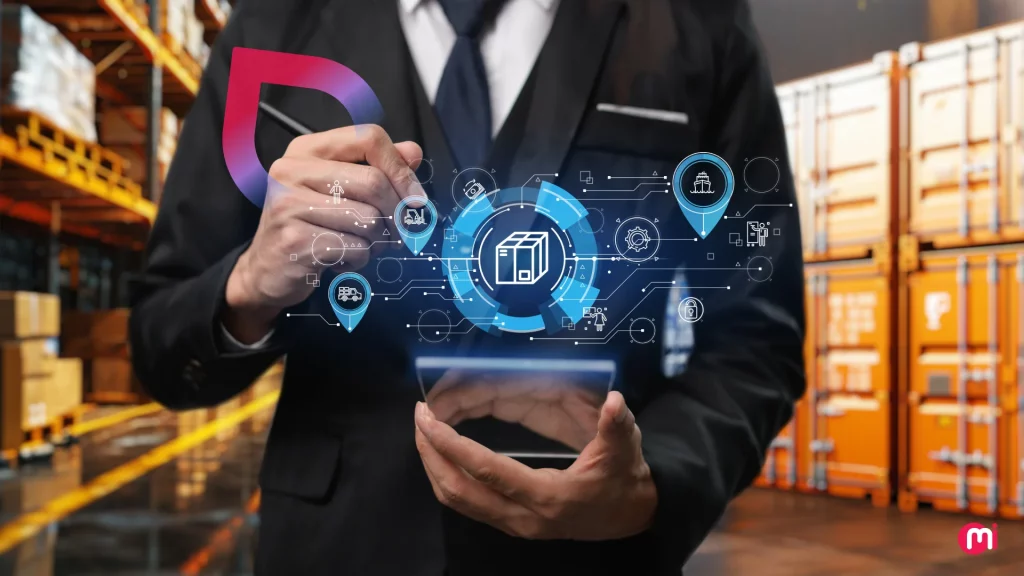
4. Robotics and Automation: Streamlining Warehousing and Fulfillment
AI-powered robotics and automation technologies are transforming warehousing and fulfillment operations, which are critical components of global retail supply chains. Robots can be used to automate tasks such as sorting, picking, packing, and transporting goods, improving efficiency, reducing labor costs, and minimizing human error.
Automated Warehouses with AI-Powered Robotics
Leading retailers such as Amazon have implemented fully automated warehouses, where AI-powered robots work alongside human employees to fulfill orders. Amazon uses a combination of robotic arms, conveyor belts, and AI algorithms to streamline its fulfillment process. Robots can pick and pack products with incredible speed and accuracy, reducing the time it takes to process orders.
One of the most famous examples of AI-powered automation in Amazon’s warehouses is the Kiva Robots. These autonomous robots move shelves of products to human workers, who then pick the items and prepare them for shipment. By optimizing warehouse operations with AI, Amazon has been able to drastically reduce operational costs and improve delivery speed, providing customers with faster service.
Robots in Retail Fulfillment Centers
In addition to Amazon, other retailers like Walmart and Ocado (a UK-based online supermarket) have embraced AI-powered robots to automate various aspects of their fulfillment centers. Ocado’s robots, for instance, use AI algorithms to navigate the warehouse and pick items with exceptional precision. These robots also work together in a coordinated manner, ensuring that products are moved efficiently throughout the warehouse.
The use of AI-driven robotics in warehousing and fulfillment centers is revolutionizing the supply chain, increasing throughput while lowering operational costs. As the technology continues to improve, we can expect even more retailers to implement AI-driven robotics across their operations.
5. Enhancing Customer Experience through AI-Driven Supply Chains
AI is also enhancing the customer experience by providing retailers with the tools to meet customer expectations for speed, personalization, and reliability. AI-driven supply chains allow retailers to offer more responsive services, personalized product recommendations, and faster delivery times.
Faster Delivery Times
With AI-powered systems, retailers can offer faster and more accurate delivery services. AI helps optimize delivery routes, predict demand, and automate warehouse operations, all of which contribute to quicker and more reliable delivery times. Retailers like Amazon have set the benchmark for fast delivery, with options like same-day or next-day delivery, thanks to AI-driven supply chain innovations.
Personalized Customer Recommendations
AI enables retailers to provide more personalized shopping experiences by recommending products based on individual customer preferences, purchase history, and browsing behavior. Nike, for example, uses AI to offer personalized recommendations through its app, based on customer data and previous interactions. This level of personalization enhances the shopping experience, leading to higher customer satisfaction and increased sales.
6. The Future of AI in Supply Chain Management
The future of AI in supply chain management is incredibly promising, with continuous advancements in machine learning, robotics, and predictive analytics. As technology evolves, AI will continue to drive innovation in the retail supply chain, enabling retailers to further optimize their operations, reduce costs, and enhance the customer experience. Key trends to look out for include the increased use of autonomous vehicles for deliveries, the integration of blockchain for better supply chain transparency, and the continued evolution of AI-driven predictive analytics.
Conclusion
AI has transformed the way global retailers manage their supply chains, from optimizing logistics and inventory management to improving demand forecasting and enhancing customer experiences. The real-world examples of companies like Amazon, Walmart, Home Depot, Zara, and Unilever demonstrate how AI can drive significant operational improvements, reduce costs, and increase efficiency. As AI technologies continue to evolve, the impact on supply chain management will only grow, providing retailers with even more powerful tools to meet the demands of the modern consumer.











